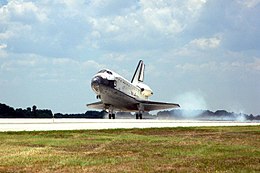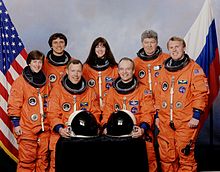STS-91

Discovery lands at the Kennedy Space Center's Shuttle Landing Facility, concluding STS-91 and the Shuttle-Mir program
|
|||||
| Mission type | Shuttle-Mir | ||||
|---|---|---|---|---|---|
| Operator | NASA | ||||
| COSPAR ID | 1998-034A | ||||
| SATCAT № | 25356 | ||||
| Mission duration | 9 days, 19 hours, 54 minutes, 2 seconds | ||||
| Spacecraft properties | |||||
| Spacecraft | Space Shuttle Discovery | ||||
| Landing mass | 117,861 kilograms (259,839 lb) | ||||
| Payload mass | 16,537 kilograms (36,458 lb) | ||||
| Crew | |||||
| Crew size | 6 up 7 down |
||||
| Members |
Charles J. Precourt Dominic L. Pudwill Gorie Franklin R. Chang-Diaz Wendy B. Lawrence Janet L. Kavandi Valery Ryumin |
||||
| Landing | Andrew S. W. Thomas | ||||
| Start of mission | |||||
| Launch date | 2 June 1998, 22:06:24 UTC | ||||
| Launch site | Kennedy LC-39A | ||||
| End of mission | |||||
| Landing date | 12 June 1998, 18:00:18 UTC | ||||
| Landing site | Kennedy SLF Runway 15 | ||||
| Orbital parameters | |||||
| Reference system | Geocentric | ||||
| Regime | Low Earth | ||||
| Perigee | 350 kilometres (220 mi) | ||||
| Apogee | 373 kilometres (232 mi) | ||||
| Inclination | 51.7 degrees | ||||
| Period | 91.8 min | ||||
| Docking with Mir | |||||
| Docking port | SO starboard | ||||
| Docking date | 4 June 1998, 16:58 UTC | ||||
| Undocking date | 8 June 1998, 16:01 UTC | ||||
| Time docked | 3 days, 23 hours, 3 minutes | ||||
|
|
|||||


Left to right - Front: Gorie, Precourt; Back: Lawrence, Chang-Diaz, Kavandi, Ryumin, Thomas
STS-91 was the final Space Shuttle mission to the Mir space station. It was flown by Space Shuttle Discovery, and launched from Kennedy Space Center, Florida, on 2 June 1998.
STS-91 marked the final Shuttle/Mir Docking Mission. This Phase 1 Program was a precursor to the International Space Station maintaining a continuous American presence in space and developing the procedures and hardware required for an international partnership in space.
The mission was the first to use the super lightweight external tank (SLWT) which was the same size, at 154 feet (47 m) long and 27 feet (8.2 m) in diameter, as the external tank used on previous launches, but 7,500 pounds (3,400 kg) lighter. The tank was made of an aluminium lithium alloy and the tank's structural design had also been improved making it 30 percent stronger and 5 percent less dense. The walls of the redesigned hydrogen tank were machined in an orthogonal waffle-like pattern, providing more strength and stability than the previous design. These improvements would later provide additional payload capacity to the International Space Station.
Docking of Discovery to Mir, the first for that orbiter, occurred at 16:01 UTC, 4 June 1998 at an altitude of 208 miles. Hatches opened at 2:34 pm the same day. At hatch opening, Andy Thomas officially became a member of Discovery’s crew, completing 130 days of living and working on Mir. The transfer wrapped up a total of 907 days spent by seven U.S. astronauts aboard the Russian space station as long-duration crew members. During the next four days, the Mir 25 and STS-91 crews transferred more than 500 kilograms (1,100 lb) of water, and almost 2,130 kilograms (4,700 lb) of cargo experiments and supplies were exchanged between the two spacecraft. During this time, long-term U.S. experiments aboard the Mir were moved into Discovery’s middeck locker area and the SPACEHAB single module in the orbiter’s payload bay, including the Space Acceleration Measurement System (SAMS) and the tissue engineering co-culture (COCULT) investigations, as well as two crystal growth experiments. The crews also conducted Risk Mitigation Experiments (RMEs) and Human Life Sciences (HLS) investigations. When the hatches closed for undocking at 9:07 am, 8 June, and the spacecraft separated at 12:01 pm that day, the final Shuttle-Mir docking mission was concluded and Phase 1 of the International Space Station (ISS) program came to an end.
...
Wikipedia
